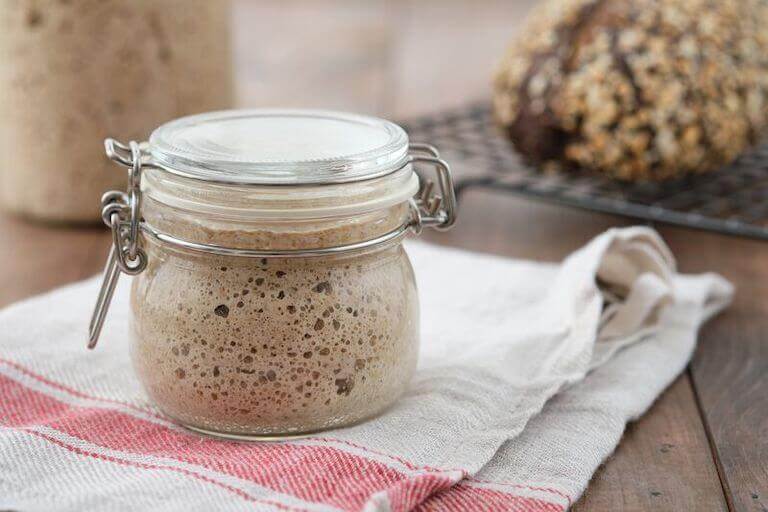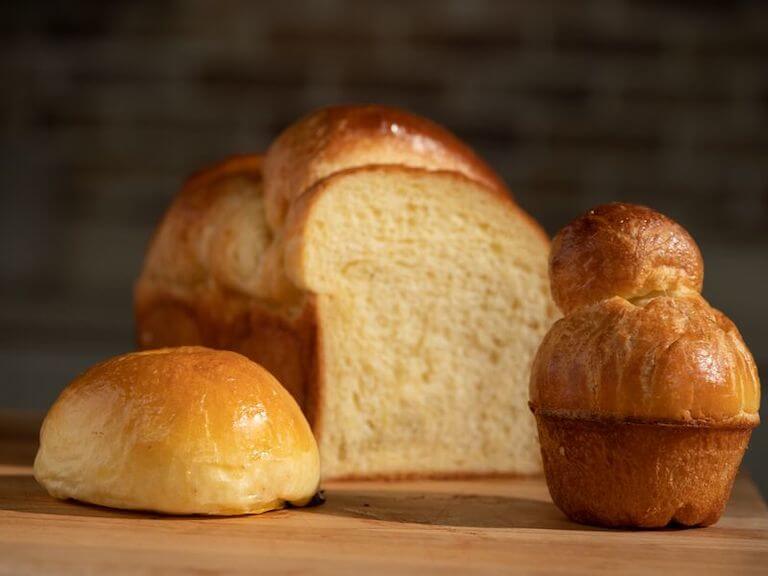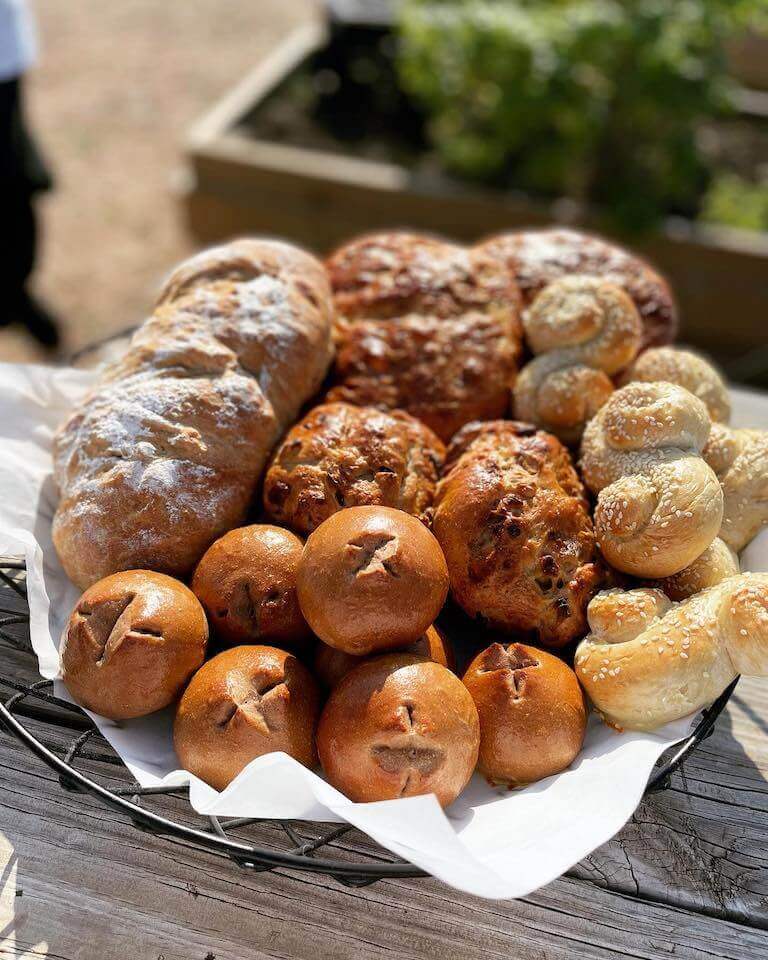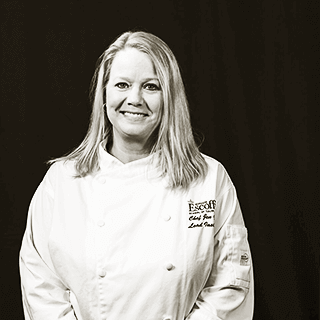Churning out a loaf of bread might seem as simple as combining flour, water, and a bit of yeast and then popping the dough in the oven. But if you’ve ever tried to bake a loaf of bread with an airy interior and crisp crust, you know baking bread isn’t as simple as it may seem!
A lack of knowledge can lead to dense loaves reminiscent of bricks or bread that rises fast…only to sink quicker than the Titanic. If you’d like to avoid these problems and churn out loaves you’re proud of, a bread baking class may be able to help.
Students in Escoffier’s Baking & Pastry programs spend part of their time exploring what it takes to make noteworthy bread. Here’s some of what they may learn.
Mixing and Working with Preferments
Levains, bigas, poolishes, pâte fermentées. What’d you say? While these terms may be unfamiliar to students at the start of a bread baking class, students can have the chance to explore the meanings and uses of these various preferments.
A preferment is a mixture of flour, water, and leavening agent that’s allowed to ferment before it’s added to the rest of the dough. By incorporating one of these mixtures into your baking, you’ll be able to add more complex aromas and flavors without the worry of over-proofing your dough.

Sourdough starter
Bread baking classes can help you distinguish the difference between each type of starter, as well as the best way to work with each one. With this information in hand, you can continue to play with temperature, flours, and methods to create a preferment that’s all your own.
The Science of Baking at Different Temperatures
Finding and maintaining the correct temperature is an essential part of the bread baking process. Whether you’re letting a dough rise or baking a loaf in the oven, a temperature that is too low or too high can lead to disappointing results.
Setting an oven to 450ºF may not be too difficult, but determining what temperature you should bake a brioche vs. a whole wheat boule vs. a bagel can be a bit trickier. And knowing the differences that occur between a fast (high temperature) and slow (low temperature) fermentation may allow you to better create a bread that meets your goal.
In Escoffier’s bread baking classes, students are taught by Chef Instructors who are experts in their field. Their baking lives have exposed them to thousands of loaves of bread, which has given them the ability to understand the causes of common issues. While you may not be able to pinpoint why your country loaf was done on the inside before it developed a golden brown crust, these mentors can help determine the cause and offer suggestions for improvement.
Handling and Shaping Dough
Just as the fermentation time and baking temperature impact your bread, so does the way you handle your dough!
Should you throw your dough in a mixer with a dough hook or knead it by hand? How do you shape your finished dough so it forms a tight boule or a perfect baguette? And how do you keep the sticky dough from coating your hands? Bread baking classes may be able to help you answer these questions, whether you’re learning in-person or online.
“As a former student here, I learned early on that baking is actually a true science. Learning the ‘why’ behind the ingredients being used, understanding why a certain technique is being used, allows you as a student to strengthen your skills.”*
Jen Gross, Pastry Lead Chef Instructor
Online baking school at Escoffier has been specifically designed so students can explore and practice crucial skills. By utilizing elements like live video lessons, group discussions, and written summaries that Chef Instructors review, students can improve their baking skills from their own homes.
Since students in Escoffier’s baking courses can complete multiple bread baking assignments throughout their programs, they can have multiple opportunities to practice handling dough. And this means more opportunities for improvement! While the first time shaping a baguette may come out subpar, students can gain tips from their Chef Instructors and take that feedback into future assignments and bakes.
Creating Enriched Doughs
Along with exploring how to combine water, flour, salt, and yeast to form a variety of breads, bread baking school can also introduce you to how to incorporate ingredients like butter and sugar. The end result? Flaky croissants, rich and pillowy brioche, and other delectable treats.

With both the knowledge and skills to create savory and sweet doughs in your repertoire, you may be able to create a wider variety of items in your home bakery.
Planning for Bread Production at a Commercial Scale
Did you know that some types of bread can take multiple days to make? That means that knowing how to properly plan for and manage the production of bread is crucial—especially if you want to sell your products at a commercial scale.
As you make multiple loaves of bread throughout your class, you may be able to better understand how long each part of the production process takes. Knowing the time a poolish needs to ferment, the hours it takes a dough to complete its first rise, and the minutes a loaf needs to rise in a proofing basket can help you make sure your bread is ready when you need it.
Since all Escoffier Chef Instructors have industry experience, they may be able to help answer questions about what it’s like to plan, produce, and bake hundreds of loaves of bread each week. And if you enroll in Escoffier’s Baking and Pastry program, you may have the chance to practice production skills during a hands-on externship.

Mixed breads by Escoffier Baking & Pastry student Jacey M.
Expand Your Bread Baking Skills
Do you dream of baking baguettes that have crisp golden crusts, an open crumb, and complex flavors? Have you always wondered why your loaves collapse halfway through their time in the oven? Then bread baking classes could be for you!
Whether you aim to open a bakery or are looking to improve your already existing skills, education can help. Students in Escoffier’s baking & pastry programs explore numerous facets of bread making as well as kitchen fundamentals and the process of making sweets like cakes and cookies.
If you’re interested in improving your baking skills, contact us to learn more about our programs.
To learn more about baking and pastry, read these articles next:
- What Can You Learn in a Cake Decorating Class?
- What Are the Baking and Pastry Arts…And Is It a Career for You?
- Six Skills Every Baker Should Have
*Information may not reflect every student’s experience. Results and outcomes may be based on several factors, such as geographical region or previous experience.

 “As a former student here, I learned early on that baking is actually a true science. Learning the ‘why’ behind the ingredients being used, understanding why a certain technique is being used, allows you as a student to strengthen your skills.”*
“As a former student here, I learned early on that baking is actually a true science. Learning the ‘why’ behind the ingredients being used, understanding why a certain technique is being used, allows you as a student to strengthen your skills.”*